The Scrovegni Chapel (Padua): Giotto, Color, and the Dawn of the Renaissance
- The Introvert Traveler
- Aug 3
- 10 min read
Updated: Sep 3

Last visit: February 2025
My rating: 10/10
Visit duration: 30 minutes
Date: 1300
In northern Italy lies a magnificent, small city which, fortunately, despite its artistic treasures and its own beauty, has not yet been overtaken by mass tourism. This is somewhat paradoxical, not only because Padua is a city of immense historical importance, shaped by the cultural influence of nearby Venice—visible in every building and street—but also because among its numerous artistic marvels there exists one that is fundamental to the history of Italian art and pivotal in launching that extraordinary artistic phenomenon later known as the Italian Renaissance.
At the heart of Padua, the Scrovegni Chapel stands as a critical junction in the evolution of Western art—a rupture with the past, and at the same time, the birth of a modern artistic vision.
Giotto's fresco cycle in the Scrovegni Chapel is likely not his first major project (both the dating and the attribution of the Assisi frescoes remain debated, though it is generally accepted that they precede those in Padua), yet it is undoubtedly his most revolutionary. It served as inspiration for generations of artists, establishing the fresco technique as a dominant medium that would immortalize some of the most important works in art history on the walls of Italian buildings.
The walls of this modest structure become the site of a visual and conceptual revolution achieved by Giotto in the early years of the 14th century: no longer merely illustrating sacred episodes, he incarnates them in space and time, returning to the sacred narrative a sense of anthropological weight and adherence to tangible reality. This made possible, in the centuries to follow, the works of Masaccio and Piero della Francesca, Michelangelo and Caravaggio.
Commissioned by Enrico Scrovegni—as an ambiguous act of devotion and social redemption—the chapel is entirely covered in frescoes with the structural discipline of a theological poem and the invention of a treatise on visual perception. The spatial organization of the cycle, arranged in three superimposed registers, reveals a narrative rationality anticipating the perspectival logic of the Renaissance. The regular alternation of episodes, the symmetry of Marian and Christological scenes, and the inclusion of coherent architectural elements all contribute to a compositional unity rarely seen in medieval art.
What renders Giotto's work truly extraordinary is not only his ability to embody sacred narratives, but his unprecedented attention to the inner life of the characters: emotions, for the first time, are visible—almost tangible—on the mural surfaces. The kiss between Joachim and Anna is one of the first instances of conjugal tenderness in Western painting; the Virgin's restrained grief in the Deposition, the horrified expressions in the Massacre of the Innocents, the emotional eruption in the Betrayal of Judas: each scene is a gestural and psychological micro-drama, infusing sacred narrative with a previously unseen communicative force.
The Chapel's significance goes beyond stylistic innovation; it is, in a sense, a visual summa of a new Christian anthropology. Man appears no longer as a mere conduit toward the divine, but as a participant in the drama of salvation, incarnate in space and time. The spatiality, though still lacking Brunelleschian perspective, is conceived as a three-dimensional stage where bodies possess volume, weight, and gravity. Light itself is not decorative but constructive: it shapes forms, paces the narrative, and guides the viewer's gaze.

History of the Chapel
The Scrovegni Chapel—also known as the Arena Chapel due to its location near the ruins of the ancient Roman amphitheatre of Padua—was built by Enrico Scrovegni, a wealthy banker and son of the infamous Reginaldo, whom Dante placed in Hell among the usurers (Inferno, XVII, 64–67). Enrico’s decision to erect the chapel was likely driven by a dual intent: on the one hand, devotional and expiatory; on the other, familial and celebratory, meant to elevate the reputation of a lineage whose wealth was often viewed with moral suspicion.
Constructed between 1300 and 1303 as part of a broader residential complex built by Enrico on the site of the Roman arena, the chapel's architectural plan was likely simple from the outset: a single nave with a barrel vault, devoid of lateral chapels, conceived both as a private oratory and as a family burial place. Enrico himself was interred there in 1336, though his funerary monument has since been lost.
On 14 March 1305, the chapel was solemnly consecrated by Ottobono de’ Razzi, Bishop of Padua, on the feast of the Annunciation, as recorded in the commemorative inscription still visible inside.
Between 1303 and 1305, Giotto di Bondone, commissioned by Enrico to decorate the interior, completed what is unanimously regarded as the masterpiece of proto-Renaissance painting. In under two years, with the support of an efficient workshop, Giotto executed approximately forty scenes distributed across three registers: the Stories of Joachim and Anna, the Life of the Virgin, and the Life and Passion of Christ, culminating in the Last Judgment on the counter-façade.
This was not merely an aesthetic decision, but also a theological and political one: among the torments of the damned, Enrico had Giotto depict a condemned usurer—clearly referencing his own father—as a public gesture of familial redemption.
After Enrico's death and the progressive extinction of the Scrovegni family in the 14th century, the chapel fell into neglect and semi-abandonment. The adjoining palace was demolished in the 18th century and the area redeveloped, though the chapel survived—stripped of its original context and preserved more by inertia than by conscious protection.
Over the centuries, water infiltration, ground movement, and general neglect caused considerable damage to the Giotto cycle. Only in the 19th century, amidst a broader effort to safeguard Italy’s artistic heritage, did the value of the monument begin to be acknowledged.
The first systematic restorations took place between 1860 and 1870, though they were often invasive by today’s standards. It was only in the 20th century that scientifically rigorous conservation began.
On 11 March 1944, the chapel miraculously survived a bombing raid that destroyed the apse of the nearby Church of the Eremitani and the Mantegna frescoes within.
A major restoration was carried out by Giuseppe Basile between 2001 and 2002, preceding the chapel’s inclusion in Padua’s UNESCO nomination.
In 2021, the Scrovegni Chapel was inscribed as part of the serial World Heritage Site “14th-century fresco cycles of Padua,” alongside other artistic complexes in the city.
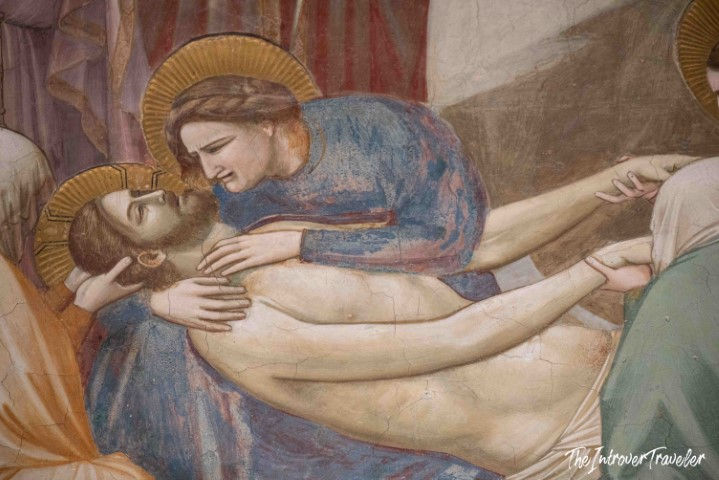
The Commission: bringing Giotto to Padua
The commission to Giotto for the decoration of the Scrovegni Chapel in Padua was likely granted around 1303, by which time the artist was already acknowledged as the foremost innovator in Italian painting. Following his achievements in Rome (San Giovanni in Laterano) and possibly in Assisi, Giotto had gained extraordinary fame for his ability to convey volume, expression, and realism in sacred subjects. Enrico Scrovegni, seeking to elevate the status and moral image of his family, chose the most renowned and in-demand painter of his day to undertake a cycle that would mark a definitive break with Byzantine tradition.
The execution of the work was swift, methodical, and remarkably efficient, testifying both to the organization of Giotto’s workshop and to the conceptual clarity of the project.
According to the most authoritative sources, Giotto began painting in 1303, immediately after the chapel’s architectural completion, and concluded by 1305, the year of its liturgical dedication on 25 March, the feast of the Annunciation. The entire cycle was therefore completed in just about two years—a remarkably short time given the scale and complexity of the undertaking.
Work progressed section by section, following the traditional a giornate method of fresco painting: the plaster (first the rough arriccio, then the finer intonaco) was applied only on the area the painter could complete within a single day, ensuring the pigments would chemically bind to the fresh lime.
The narrative layout was coherently planned from the outset: three registers along the side walls—one for the stories of Joachim and Anna, one for the life of the Virgin, and one for the life and Passion of Christ. The Last Judgment fills the counter-façade, while allegorical figures of Virtues and Vices run along the lower register in a rigorously moral and theological structure.
By this stage of his career, Giotto operated with a stable, specialized workshop composed of skilled assistants and possibly some pupils. It is likely that Giotto himself executed the most important parts (principal faces, central scenes, preparatory cartoons), delegating decorative or marginal elements to his team. The overall stylistic coherence, however, demonstrates tight control by the master—unlike the frescoes in Assisi, whose stylistic inconsistencies have long raised doubts about Giotto’s authorship.
Giotto’s intervention was also a laboratory for technical and expressive innovation: controlled use of light and shadow to model volumes, believable architecture to define space, gestures and postures that convey authentic emotion. Each fresco is a self-contained scene, yet also part of a vast unified narrative.
The work was completed in time for the 1305 dedication, and even then must have stood out as a unicum in Italian art: a coherent, didactic, emotionally resonant cycle, intended not just for private devotion but for the spiritual and moral education of the viewer.

Description of the Artwork
The fresco cycle unfolds across three principal registers along the nave walls: the Stories of Joachim and Anna, the Life of the Virgin, and the Life of Christ. These are complemented by the Virtues and Vices painted in monochrome along the lower register as faux sculptures, and the Last Judgment on the counter-façade.
Giotto begins with the apocryphal tale of Mary’s parents, Joachim and Anna, infusing it with profound humanity. The Rejection of Joachim's Offering, his Flight into the Wilderness, and especially the Meeting at the Golden Gate are masterworks of pathos and tenderness. In the latter, the elderly couple’s embrace and kiss constitute one of the earliest depictions of conjugal affection in Western art, rendered with psychological depth that prefigures modernity.
The second register narrates the life of Mary, including the Annunciation, painted on the triumphal arch’s vaults, with the angel and the Virgin facing each other in a perfectly balanced architectural space. The composition here is austere, almost classical. The Visitation, the Presentation at the Temple, and the Nativity of Mary are articulated within a three-dimensional space that anticipates Renaissance perspective.
The third and most emotionally charged register recounts Christ’s Passion. The Entry into Jerusalem reveals Giotto’s interest in narrative simultaneity: crowds clamor and climb trees in anticipation. The Kiss of Judas is claustrophobic and intense—Judas’s embrace becomes a visual trap. The Last Supper, Lamentation, and Crucifixion are among the cycle’s most moving scenes. In the Lamentation, a diagonal composition, the central void between Christ’s body and Mary’s outstretched arms, the eloquent gestures of the mourners, and the anguished women kneeling at the foot of the cross create a suspended, tragic moment of silence.
The Last Judgment on the counter-façade is an apocalyptic, theological climax. Christ, enthroned in a cosmic mandorla, presides over the separation of the blessed and the damned. To the left, the saved ascend in order; to the right, the damned are rendered with stark plasticity and chromatic force. At the center, Enrico Scrovegni is depicted kneeling, offering the chapel to the Virgin—a visual affirmation of the cycle’s penitential intent.
The monochrome Virtues and Vices along the base are painted as fictive sculptures—an illusionistic nod to the classical world, and a moral journey interwoven with the narrative above.
Giotto’s work is revolutionary in at least two respects. First, in his rendering of space: one finds early examples of spatial coherence and proto-perspective that precede Renaissance theory by a century. Second, in his portrayal of the human figure: physicality and emotion are central. This is especially evident in scenes like the tender Meeting at the Golden Gate—the first kiss in Italian art—and the anguished Massacre of the Innocents, where the mothers’ grief is startlingly realistic. Emotions are portrayed with an expressivity rare not only for the Middle Ages but for all of Italian art—with few exceptions, such as Niccolò dell’Arca’s Lamentation over the Dead Christ.
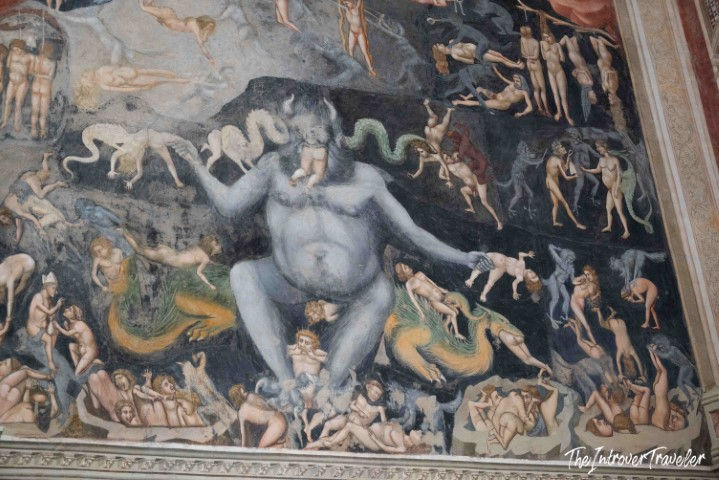
The Use of Color
Upon entering the chapel, the first impression is the astonishing chromatic richness of the frescoes.
Giotto employed a surprisingly wide palette, yet always subordinated to a rigorous compositional logic. Colors were never chosen for mere decoration, but for their narrative and symbolic function. In backgrounds, garments, and architectural elements, color constructs spatial depth, guides the viewer’s eye, and defines visual hierarchies. A distinction must be made between pigments applied a fresco (on wet plaster) and those applied a secco (on dry plaster), used for decorative or corrective purposes.
The most renowned and costly pigment in the cycle is undoubtedly ultramarine blue, derived from Afghan lapis lazuli (mined in Sar-e-Sang, Badakhshan). Due to its long overland journey via the Silk Road and its complex refinement (grinding, decanting, impurity removal), lapis lazuli was more expensive than gold and often accounted for separately in contracts.
Giotto reserved this precious blue for the Virgin’s robes, heavenly backgrounds, and select details. In many scenes, the ultramarine is applied a secco, as it was chemically incompatible with wet plaster. However, this method made it more vulnerable over time to fading and oxidation—today, several areas appear muted or dull, bearing witness to the technical and symbolic cost of this choice.
Unlike Byzantine painting, Giotto avoided extensive use of gold leaf, preferring to construct sacredness through natural light and volumetric modeling. Gold appears only in limited details—haloes, architectural friezes—and is sometimes simulated with painted effects (so-called "false gold"), marking a shift in the depiction of the divine: no longer abstract and unreachable, but immanent and embodied.
His palette also included:
Natural earths: yellow ochre, green earth, umber—affordable, stable, ideal for true fresco.
Vermilion (mercury sulfide): bright red, but unstable and toxic—used sparingly.
Cinnabar: a mineral variant of vermilion, equally costly.
Malachite: vivid green, expensive and difficult to handle—used in garments or symbolic backgrounds.
Lead white and carbon black: functional pigments for chiaroscuro and underpainting.
The pictorial enterprise of the chapel was extraordinarily expensive, and pigment selection accounted for a major portion of the cost. The use of ultramarine, vermilion, and intense greens suggests not only a desire for splendor but also Enrico Scrovegni’s intent to display wealth, status, and penitence through art. In the medieval worldview, color held theological value: blue for the Virgin was not merely beautiful, but a doctrinal affirmation of her central role.
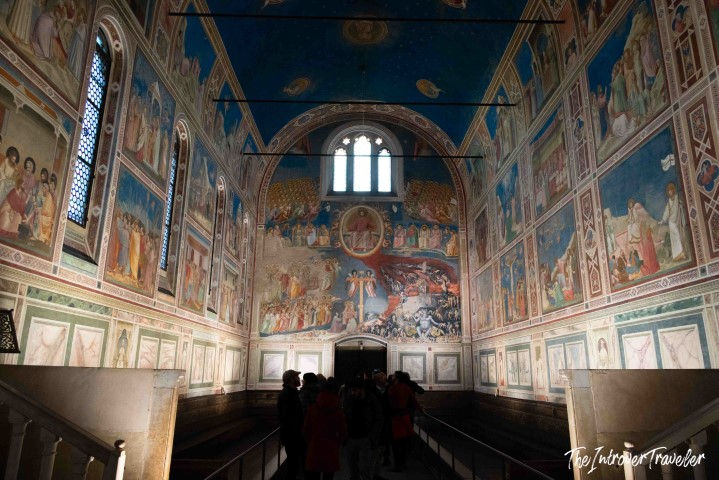
Visiting the Scrovegni Chapel
Access to the chapel is strictly limited for conservation reasons: Giotto’s frescoes, painted directly onto delicate medieval walls, are highly sensitive to microclimatic changes caused by visitors’ humidity and CO₂ emissions. For this reason, before entering the chapel itself, visitors are held in a climate-controlled antechamber for about 15 minutes. This interval allows the environment to stabilize, ensuring safe conditions for the artworks.
Booking must be made well in advance, often weeks ahead—especially during high tourist seasons such as spring, holidays, and summer. Entry slots are fixed, with very little tolerance for delays.
Once inside, the viewing time is extremely limited: around 15 minutes, timed precisely. This restriction—necessary for preservation—is perhaps the most frustrating paradox of the entire experience: one is immersed in one of the most extraordinary pictorial cycles in art history, yet must fight against the tyranny of the clock. Scenes unfold rapidly, and the thoughtful visitor is forced to make choices: focus on a single wall, a register, or a particular episode? Or attempt a general survey, at the risk of overlooking the semantic richness of individual details?
Authentic contemplation is necessarily compressed. Therefore, anyone hoping to fully absorb the experience should ideally study the cycle beforehand, using high-resolution reproductions or scholarly guides, to know where to direct their gaze, what to look for, and what not to miss. In my opinion, it is well worth reserving two consecutive visits, even if it's expensive, as 15 minutes is far from sufficient to contemplate and appreciate the entire cycle.
After visiting the Chapel, one must also take time to visit the nearby Church of the Eremitani, home to the mutilated frescoes of Mantegna, tragically damaged by American bombing in 1944.















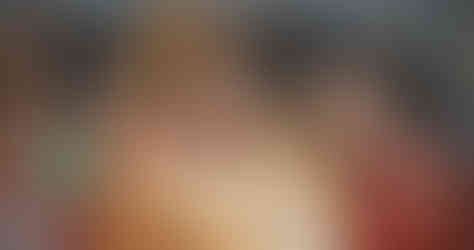



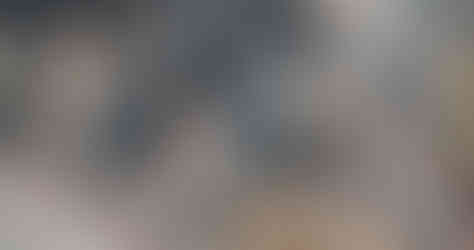


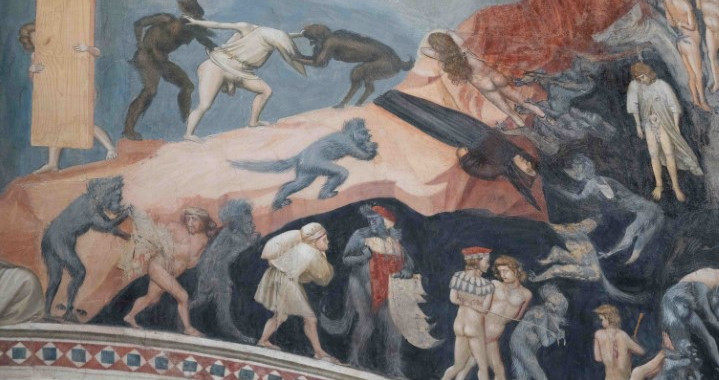
























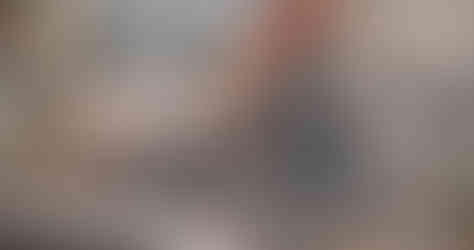





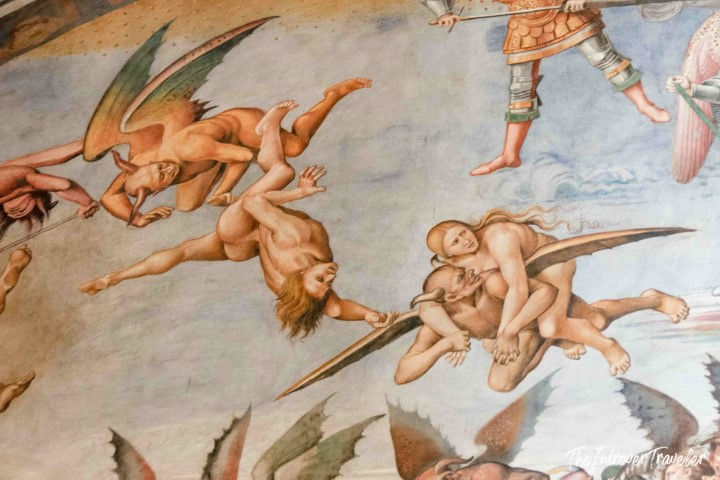


Comments